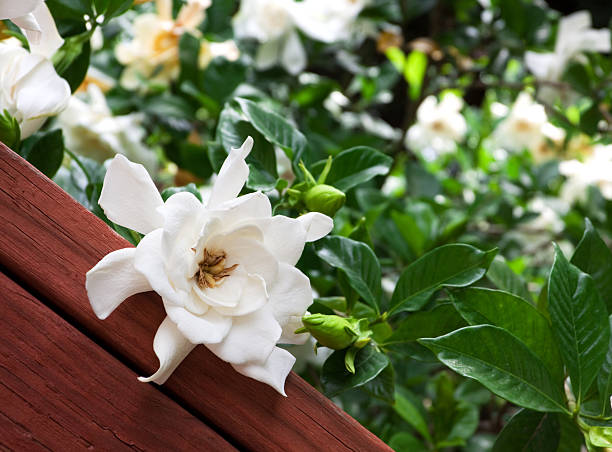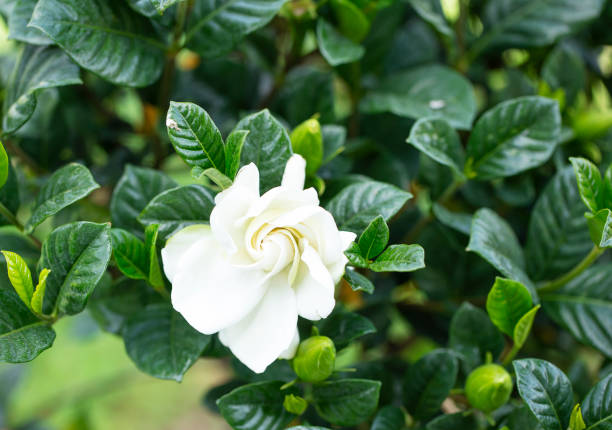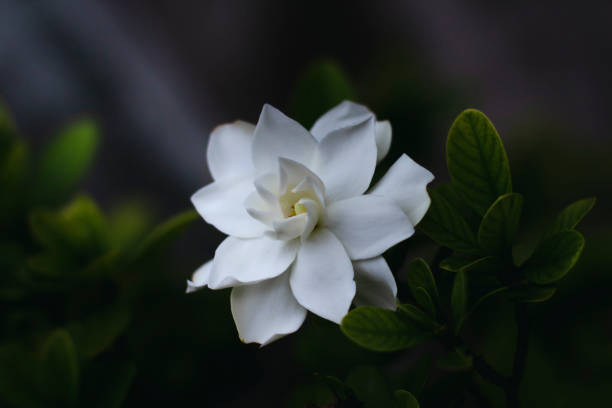How To Propagate Gardenia: The Ultimate Guide For Beginners!
Propagating Gardenia is not a difficult process, so we are glad to give you the ultimate guide for beginners. This article will tell you the basic steps to grow varieties of gardenia for planting in your home or office, so sit down and enjoy reading!

Table of Contents
Propagating From Cuttings
Take cuttings in mid-spring until late summer. The best time to cut is from mid-spring to late summer when the weather is continuously warm and the flowers are actively blossoming. The cuttings are ready to grow when taken during the flowering season. Since the gardenia growth season is generally done by the fall, cuttings obtained at that time will not grow as well. The branches will get increasingly dried out and brittle.
Ensure to use sterilized pruning shears. This would prevent harmful pests and diseases passed to the newly cut stems. You can disinfect your tool using isopropyl alcohol, ethanol Lysol, or any other household disinfectants. Bleach and trisodium phosphates can be also efficient in killing pests but your tools can be prone to rust.
Start by cutting a 4-5 inches (10.-13 cm) stem from a matured branch 6-8 weeks old. Avoid cutting the branch at a node by trimming it 4 inches from the tip or middle of the branch. Remove the foliage from the base. Leave a few leaves on the top half. Remove the flower from the cutting as well. The cutting will have a difficult time establishing a root system if it is exposed to a bloom.
Pour an equal amount of peat moss and sand in a well-drained small pot. Mix all ingredients until it’s even. Perlite and vermiculite, or perlite and peat moss, are equally viable options.
Plant the stem cutting. Get a pot for the cutting to root. Rooting hormone powder may be used to speed up the development of the angled-cut root. 1-2 inches of soil depth is sufficient for planting the cutting. Before planting, dig a hole. Leave at least 3 inches of plant spacing if you are planning to plant multiple cuttings.
Poor water moistens the roots. The soil around the stem cutting should be damp and lightly water. To decrease water loss from the foliage, sprinkle them with your spray bottle and cover them with a plastic bag.
Place the pot in indirect sunshine at a temperature of at least 24°C (75°C). Indirect sunlight is essential for plants to thrive. Another option is to utilize a greenhouse.
Put the plant in a big plastic bag to keep it humid. Gardenias thrive in moist environments. If your area isn’t too humid, wrap the pot with a large plastic bag. Blow some air into the bag to expand it, then close it. Allow no leaves to come into contact with the plastic. So they are more prone to mold exposure. More air or a bigger bag will offer the leaves more room. To water, open the bag and close it again.
Propagating From Seed
The maturation period for gardenia seedlings is lengthy. Gardenia seedlings require two to three years to flower. Even if it takes a long time, youngsters may find the procedure interesting. Planting in huge quantities at a low cost. Pods that were once a brilliant orange or crimson color on a shrub have faded. It’s most common in the last week of October.
When you put seed-starting mix into a four-inch container with drainage holes, add a few inches. It’s best to plant five or six seeds 1/4-inch deep and a few inches apart. After watering the soil, wait for it to be totally dry before planting.
Put a plastic bag over the top. Place the container in the shade so the seed may grow. Temperatures of 23.9° Celsius (75° Fahrenheit) are excellent for germination. Temperature fluctuations are permitted, as long as they do not reach dangerously high or low levels. Seeds may sprout more easily with the aid of a plastic cover. Remove the plastic bag from the seeds if the soil seems to be dry, and then spritz them with water. Germination takes 4-8 weeks on average for seeds. If 50% of the plastic has germinated, you have full freedom to remove it. Place the pot in a partial sun position and moisten it always. The transplant may be done in the spring.
It is common for gardeners to save the seeds they harvest in the fall so that they may plant them right away the following year. In most cases, they have spaced about two inches apart and1/4-inch thick. When utilizing such an approach, it is more difficult to keep a consistent level of humidity, but misting may help.
Keep the seeds in a sealed container in a cold, dry place is the best way to guarantee their viability for the long term. Several seed pods are available in areas where the gardenia is hardy all year round.

Propagating from Air Layering
In the event that you already have mature plants, air layering is a viable choice. Air layering is a method of propagation that involves cutting the stem of a young plant while it is still linked to the mother plant in order to allow the new plant to take root and become self-sufficient. In order to encourage the growth of roots, the stem is draped in sphagnum moss or other moist moss. Overgrown indoor plants might benefit from this strategy.
You may start air layering in the fall or spring. The wound should be kept wet by wrapping the moss with plastic film until the roots form. Aluminum foil is another option. A mature shoot from the previous season or one that developed this year is the greatest choice for the operation.
Measure roughly a foot from the tip of the branch for a certain variety of gardenia. Take a 2-inch slice off the leaves and remove them.
Around the stem, make two parallel cuts that are 1 1/2 inches apart. Slice through the bark with a long, steady motion. To get to the woody tissue, remove the thin layer of green tissue that lies behind it. Peel back the outer layer of bark to show the woody tissue underneath, then join the two circular incisions with a single right-angled slice made with the knife.
Lightly coat the exposed surface of the pot with rooting hormone powder, and then fill the pot with moist sphagnum moss to cover the whole surface. If necessary, use biodegradable thread to tie the pot together loosely to keep the moss in place while the plant is growing and developing.
Using eight-by-12-inch sheets of aluminum foil or polyethylene film, carefully wrap the moss around the stem and twist the ends to secure it in place. To avoid the shrub breaking off, use a splint to support the cut area.
Using a spray bottle, mist the layering area from the top-down, allowing the water to flow into the packing. As long as the shell is in place, the moisture will be preserved. Gently remove the casing every 30 days or more if you can see the roots growing. It’s a good idea to swap it out every now and again.
When the roots of the children are more than an inch long, use a sharp knife or shearing pruners to remove them from the parent plant. The moss and root coating should be removed. Remove the case, but don’t worry about the moss; it may be left in situ. If you want to plant your gardenia, you may do so in a container thereafter.

Propagating Through Transplanting
For the rest of the winter, keep the soil moist and containers on the windowsill or near (but not directly under) a grow light. Plant them in the oplk.
Make a hole 3x the width of the pot in the growing area. Dig deep enough 1-2 inches covering from the top of root ball above the soil surface. Plant it in the center and cover the roots. Tamp it down lightly.
Adequately water the plants. Add a 2-inch layer of mulch.
Frequently Asked Questions:
Can I Root Gardenia Cuttings in Water?
Yes, you can. Gardenia cuttings can certainly be rooted in water. You simply need to understand how to approach things in order to achieve good results. Cut the root at an angle so that it can absorb water faster.
Is Rooting Hormone Efficient for the Stem Cuttings to Root?
Root stimulating hormone can definitely help the roots to develop faster for your stem cutting. Do not dip the stem directly into the hormone container as it can create contamination. Place a separate container. Insert the cutting stem into the root-stimulating hormone about an inch (2.5 cm). This is where the new roots will grow.
Insert the dipped stem cutting halfway into a pot of moist planting medium. The pot should be covered with a clear plastic bag. The new planting should be placed in a sunny, filtered-light location. While you wait for new root growth, keep the stem cutting moist and watch for new leaves to form. The formation of new roots is indicated by new leaves, which is a good sign. The plastic bag can be removed at this point. As your plant matures, you can begin to treat it as if it were a new one.
Are There Any Risks Associated With Propagating Gardenia Indoors or Outdoors?
There are some risks associated with propagating gardenia indoors or outdoors. The main risk is that gardenias are susceptible to pests and diseases, which can be difficult to control. Gardenias also require a lot of sunlight and humidity to grow well, so if you don’t have access to either of those things, they may not thrive.
How Fast Do Gardenias Grow From Cuttings?
You can expect that it will root for four to eight weeks. Continue to care for the cutting as usual, especially by watering it frequently and keeping it warm.
